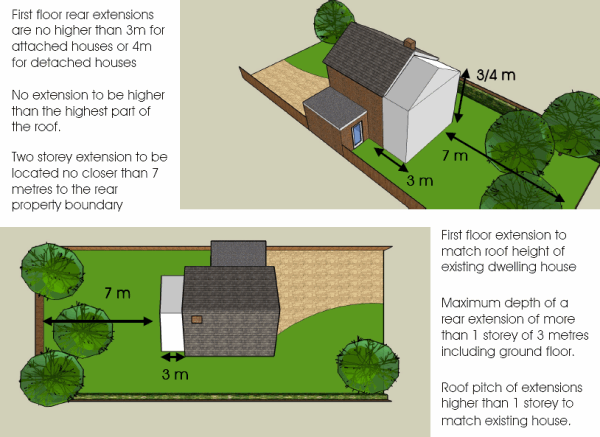- Home
- Planning Information
- Home Extensions
- First Floor and Two Storey Extensions
First Floor and Two Storey Extensions

Benefits
- Increases your living space, creating the opportunity to add an additional bedroom or bathroom etc.
- Adds value to the property
- Avoid the time, effort and costs associated with moving home
N.B. A two storey extension is not a great deal more expensive than a single storey extension as both need foundations and a roof.
Planning Permission for Extensions is not always required
Key Points
- Site Coverage: Did you know that you will need planning permission if the proposed two storey or first floor extension (when taken with existing extensions, outbuildings and decking for example), will cover more than 50% of the land around your home?
- Location: In terms of location, if your property fronts or sides a road and you wish to put an extension closer to that road then you will need planning permission. In addition, if you propose to site a 2 storey extension within 7 metres of a rear boundary, you will require planning permission.
- Height: The extension can be no higher than the highest part of the existing roof and if you are building within 2 metres of a boundary, the maximum eaves height can be no more than 3 metres. This last point will apply more to single storey as opposed to two or indeed first floor extensions.
- Depth: The maximum depth of any first or two storey extension is 3 metres.
- Veranda: You will require planning permission if you wish to add a veranda, balcony or raised platform to the structure.
- Roof Pitch and Materials: At first floor level, the roof pitch must match that of the existing house or else you will require planning permission. Similarly, you will have to use materials of a similar appearance. Again, what is considered a similar material is unclear and will be the subject of further consideration at some future point on this site.
- Windows: If you wish to add a side facing window to your first of two storey extension, it will have to be obscurely glazed and any opening part has to be located 1.7 metres above floor level.
- Cladding: Last but not least, if your house occupies designated land, you cannot clad it. What this means is not entirely clear but we will attempt to interpret this in future articles.

You might want to consider information in these additional areas:



